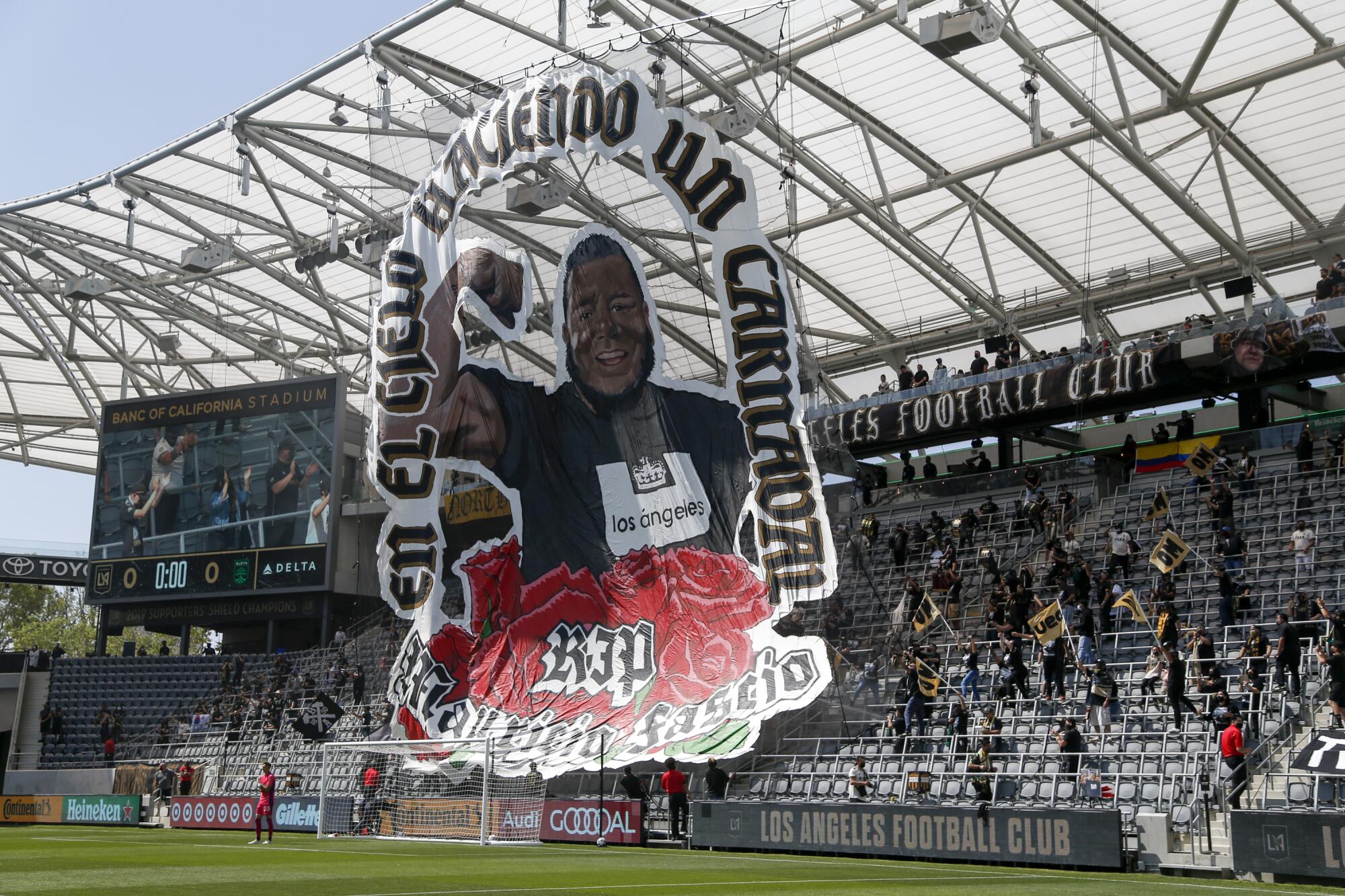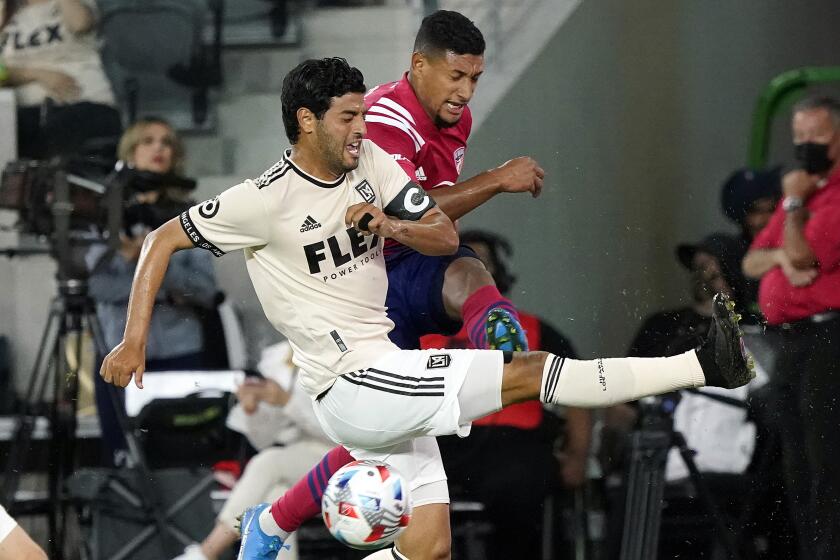
On the first day of full attendance since the pandemic, the most notable figure in the city’s most celebrated cheering section was the one who was missing. He was Mo Fascio, the stocky, smiling symbol of this city’s most vibrant, multicultural sports community.
- Share via
His fellow LAFC fans gathered on a lawn across from Mauricio “Mo” Fascio’s hospital room, flapping flags bearing his name, serenading him with drums and cowbells and love.
“¡Dale, Dale, Mo!”
Keep going, Mo!
LAFC star Carlos Vela made a video for Fascio while he was intubated and sedated, Vela staring into the phone camera, pleading for him to get well soon.
“Te mando un fuerte abrazo…”
I send you a big hug …
It was only fitting that, while Fascio was alone and battling COVID-19 this spring, the man who helped create this city’s most renowned supporters’ group had his own cheering section.
It also was fitting that Fascio responded by offering the one thing he shared for three years while building an inclusive, embracing culture that reached far beyond a soccer pitch.
He shared it when he broke up fights between LAFC and Galaxy fans. He shared it when his scolding helped silence the infamous Spanish-language, anti-gay slur. He shared it when he met with other fans on an East L.A. street to buy out the entire carts of fruit vendors.
In the end, he was too weak for words, but by then, words weren’t needed.
One of Mo Fascio’s final text messages was the emoji of a heart.
They gathered in full at the north end of Banc of California Stadium for the first time in nearly two years Saturday night, screaming and dancing and singing.
They are the renowned LAFC supporters group known as The 3252.
Only now, in reality, they are The 3251.
On the first day of full attendance since the pandemic, the most notable figure in the city’s most celebrated cheering section was the one who was missing.

He was Mo Fascio, the stocky, smiling symbol of this city’s most vibrant, multicultural sports community. He was more than the vice president of The 3252, more than a leader of the District 9 Ultras supporters group, more than one of the thousands who cheer and stomp and set off smoke with every LAFC success.
“He was our welcoming arms, he was our peacekeeper; he could inspire anybody and anything,” said Jimmy Lopez, president of The 3252.
He was even more than just the arms.
“He was our spine,” fellow District 9 member Eddie Magaña said.
On March 20 at Kaiser Permanente Downey Medical Center, a fan base’s back broke when Fascio, 54, died of COVID-19.
He is survived by wife Anna, daughter Veronica, son Ernesto and an entire sports franchise that grieved as if he was their superstar.
Which, it turns out, he was.
“If you think back to the individual contributions to what this club has become, Mauricio is among that small group of people where, we wouldn’t be what we are without him,” said Larry Freedman, LAFC co-president and chief business officer. “Everybody knew Mo, and everybody loved him.”
The deep footprint of his life was accentuated by the sizeable, sweeping grief upon his death.
“He was our welcoming arms, he was our peacekeeper; he could inspire anybody and anything.”
— The 3252 president Jimmy Lopez on vice president Mo Fascio, who died after battling COVID-19
What other fan in this city’s history made such an impact that several hundred people flocked to the team’s stadium parking lot on the night of his passing to hold an impromptu memorial service? This is what happened at Banc of California Stadium, where fans not only lauded Fascio’s memory with flowers and candles, but also wrote and sang a song in his honor.
“¡Mauri ,mauri querido … esta hinchada jamas te olvidara!”
Mauri, beloved Mauri, this supporter group will never forget you!
What other fan in any sport, anywhere, would be celebrated during the first home game after his death with what was essentially a communal wake? This is what happened at Banc of California Stadium in mid-April during the LAFC season opener against Austin FC.
The fans began the event by unfurling a giant tifo bearing Fascio’s smiling likeness. During the game, players wore arm bands reading, “Forza Mo.” Afterward, forward Latif Blessing paraded around the stadium holding up a photo of Fascio, which he then brought to the locker room so the team could pose with it, everyone wanting to touch a true hero.
“We talk about people being larger than life,” Freedman said. “Well, Mo really was.”
Finally, what fan has been so revered that the league’s commissioner tweeted out condolences and his team released a memorial video? MLS commissioner Don Garber issued a statement that read, in part, “All of us at Major League Soccer are heartbroken.” Then LAFC released an emotional short that lasted 2 minutes 29 seconds, but felt like the documentary of a royal.
“His personality and his presence and how much he loved LAFC just came across every time we got a chance to be around him,” LAFC coach Bob Bradley said during the video. “He meant an incredible amount to all of us.”
That meaning could not be found in a particular Fascio cheer, although he did have three LAFC-related tattoos on his arms.
He didn’t root harder than anyone else. He didn’t shout louder than anyone else. He didn’t wear some gaudy trademark gear or do some silly trademark dance.
His meaning could be found in his gentle ability to connect and unite and build community. He bridged the gap between the disparate supporter groups that comprise The 3252. He settled their disputes, eased their tensions, welcomed the newcomers, embraced the old-timers, enforced the rules, created the fabric.
On match day, when the most diverse fan collection on this city’s sports landscape came together and roared as one, it was with a voice enriched and enhanced by Mo.
”For 90 minutes, we can forget our mortgages, we can forget our political differences, we can forget what neighborhood we live in. For 90 minutes, we all live in the north end, we’re all together; it doesn’t matter who you are,” Fascio said a year before his death on the LAFC Shoulder 2 Shoulder podcast. “That’s what is beautiful about what we’re building in the north end … that’s what make us different from anyone else in the MLS.”
This community construction is what drew Fascio to The 3252 during the club’s first season in 2018. The Orange County social services worker was the son of Mexican-born parents, grew up in Huntington Park, attended St. John Bosco High in Bellflower on a scholarship and never quite knew where he fit in as a sports fan. He loved the Lakers and Dodgers but never felt a close connection. Then LAFC arrived, famously reached out to the town’s often-ignored fan base, and Fascio was smitten.
“He wanted a team for his city; it struck something that was central to him,” said his wife Anna Rivera, a civil rights attorney. “LAFC soccer tapped into something that could be his.”
He bought two season tickets for the north end. He tailgated with other diehards from The 3252 in Lot 6 before the new stadium was completed. He flew to Seattle for the team’s inaugural game. He returned to begin tailgating on Christmas Tree Lane. Then he just kept showing up, and organizing, and fixing, and working, and, of course, cheering.
“I thought he was nuts, I really did,” Rivera said. “Then I saw what was happening.”
She saw what happened after she and Fascio parked their black Toyota Tacoma pickup truck at the stadium as early as 10 hours before the games. She saw him move from tent to tent, grill to grill, group to group, hugging and laughing and uniting.
“I saw what he was doing, I saw what he was building,” Rivera said. “He was very much about inclusivity, about making sure people felt like part of their community.”
Then she saw him keep that community connected in loud and thumping support not only during games, but also outside the team’s workout facility during practices, and even alongside the team bus before the trip to Carson for the tumultuous battles with the Galaxy.
Take a closer look at every 2021 LAFC player and video of all the goals the team scores throughout the MLS season.
The 3252 is basically everywhere on the LAFC scene, and Mo Fascio was always in the middle of everything.
There was blood on his shirt from stopping fights because he detested fan violence. There was sweat on his shirt from embracing outsiders because he detested intolerance. There were wrinkles in his shirt for loudly confronting anyone who refused to accept everyone.
“There’s a reason we’re here … there was a segment of population of our community that was not being addressed,” Fascio said on the Shoulder 2 Shoulder podcast. “We’re building a culture, community by community, block by block, match by match, action by action.”
Perhaps his most notable action was his powerful support of the LGBTQ community’s Pride Republic supporters group. He helped it take shape, pushed for its acceptance and even helped the group paint its first tifo in his Whittier backyard, a portrait of a figure wearing a rainbow mask.
”For 90 minutes, we can forget our mortgages, we can forget our political differences, we can forget what neighborhood we live in. For 90 minutes, we all live in the north end, we’re all together; it doesn’t matter who you are.”
— LAFC 3252 vice president Mo Fascio a year before his death
“Mo was our biggest ally, our biggest advocate; he helped us get our feet on the ground,” said Paul Ruiz, president and co-founder of Pride Republic. “Sometimes you need someone to break down the barriers. Mo was the one to help us do that.”
Yet even the strongest fan in The 3252 could not win his fight with COVID-19. It had claimed the lives of his mother, Camerina, and his younger sister, Rosie Bogle. He took every precaution. It was not enough.
Fascio got sick at the end of February, entered the hospital on Feb. 28 and never again emerged. He fought the intubation until the end. He believed he could beat it until the end.
“I have lots to live for,” he wrote in a text to Lopez.
On a spring Saturday morning, this city’s greatest fan was forever silenced, but that life will continue to shine, in the tolerance he preached, in the diversity he celebrated, in the community he built.
That shine will continue to be reflected in The 3252 as they fill the north end of Banc of California Stadium, standing shoulder to shoulder on Mo Fascio’s shoulders, their repertoire containing a new song, their voices lifted in a prayer they will be singing forever.
“¡Mauri, mauri querido … esta hinchada jamas te olvidara!”
Mauri, beloved Mauri, this supporter group will never forget you!










